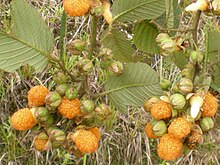Rubus ellipticus
| Rubus ellipticus | |
|---|---|
 |
|
| Scientific classification | |
| Kingdom: | Plantae |
| (unranked): | Angiosperms |
| (unranked): | Eudicots |
| (unranked): | Rosids |
| Order: | Rosales |
| Family: | Rosaceae |
| Genus: | Rubus |
| Subgenus: | Idaeobatus |
| Species: | R. ellipticus |
| Binomial name | |
|
Rubus ellipticus Sm. 1815 |
|
| Synonyms | |
|
|
Rubus ellipticus, commonly known as golden Himalayan raspberry or as yellow Himalayan raspberry, is an Asian species of thorny fruiting shrub in the rose family. It is native to China, Nepal, the Indian Subcontinent, Indochina, and the Philippines.
The golden Himalayan raspberry is a large shrub with stout stems that can grow to up to 4.5 meters, or about 12 feet long. Its leaves are trifoliate, elliptic, or obovate and toothed with long bristles. Its leaves can grow to up to 5 to 10 centimeters long, or about 3 - 4 inches. Its flowers are short, white, and have five petals and grow in clusters, and blooms in the Himalayas between the months of February and April. Its fruit are sweet, detachable, and highly sought after by birds and elephants.
Rubus ellipticus is sweet to the taste, though it is not commonly harvested for domestic use. The fruit perishes quickly after plucking from the thorny bush.
The bark from this plant is used for medical reasons in Tibetan villages, mainly as a renal tonic and an antidiuretic. Its juices can also be used to treat coughs, fevers, colic and sore throat. The plant can also be used to make a bluish-purple dye.
The golden Himalayan raspberry's origin is in the temperate Himalayas region, and is native to India, Pakistan, Nepal and China. It is spread through cultivation. It is often found in Pine forests of the region.
The golden Himalayan raspberry can be found in mesic or wet forests, and have adapted to be able to live in complete shade and in full sun exposure. As with other Rubus species, its seeds are readily distributed by birds. It can also propagate, or asexual reproduction, itself through cutting. It can grow in open fields or in canopies of moist forests.
The Himalayan raspberry can also support large populations of Drosophila, or fruit flies, from its rotting fruit, and its fruits are also consumed by elephants.
Rubus ellipticus is listed in the IUCN Invasive Species Specialist Group database as an Invasive species, one of the World's 100 worst invasive species. It was first introduced in 1961 in Hawaii as an edible fruit and as an ornamental plant.
...
Wikipedia
